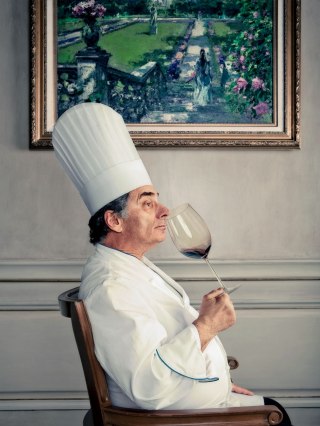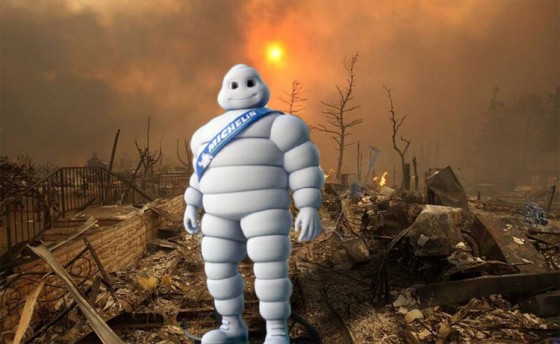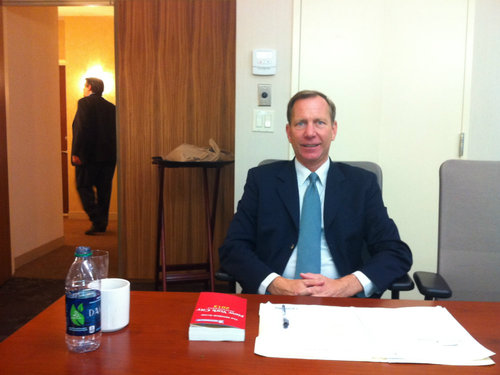Vanity Fair : Au revoir Michelin… La fin d’une époque ?
06 oct 2012
Catégorie : Presse & Médias
Un article édifiant sur le guide Michelin, son histoire et son influence, son évolution, sortira le mois prochain sur le célèbre magazine américain Vanity Fair qui appartient au groupe Conde Nast (Vogue, GQ, Glamour, AD…).
Vanity Fair conjugue, dans un style sophistiqué de l’actualité, des portraits fouillés de personnalités, du show-biz et de la politique, et de la mode. Ce magazine haut de gamme sortira prochainement en France, mensuellement, avec à sa tête une des stars de la chaîne Canal+ – Michel Denisot -.
En attendant, on se demande si cet article a été motivé par la sortie du Guide Michelin New York 2013 il y a quelques jours ? Nous n’avons pas les informations pour l’affirmer, quoi qu’il en soit cet article commence à faire du bruit dans les marmites outre-Atlantique. Nous vous laissons entreprendre sa lecture, où sa traduction pleine de subtilités, nous éclaire sur pas mal d’aspects de l’évolution de la planète » Bouffe « . C’est le critique gastronomique AA Gill qui en est l’auteur, pour lui : » le guide Michelin est totalement déconnecté de la réalité « … à vous de juger…
@
Cliquez sur le link ci-dessous pour accéder à l’original.
Michelin, Get Out of the Kitchen !
FOOD – November 2012
Just over a century ago, two French tire manufacturers created the Michelin guide. According to the author, it has blighted the lives of chefs from Brooklyn to Bombay, while spawning legions of checklist gourmands.
STAR-CROSSED The Michelin guide helped elevate chefs from being mere cooks into celebrities.
Alittle more than a hundred years ago, a pair of brothers invented the food guide. It was an inadvertent invention. What they thought they’d done was compile a directory of places in France where you could grab a baguette and a bed for the night while some rural blacksmith or farrier tried to mend your broken-down Boitel, Motobloc, Otto, or Lacoste & Battmann. The brothers, Édouard and André Michelin, made pneumatic tires and were staring down the road at the biggest blue-sky start-up industry of the new century.
The Michelin guide turned out to be prescient and inspired. This motoring thing wasn’t going to be about what you went in but where you went to. The guide quickly became not an emergency manual but a destination invitation. They added a star system—one, two, or three stars—and a hieroglyphic lexicon to show you where you could eat on a terrace, take your dog, or make a phone call.
The Michelin guide made kitchens as competitive as football teams, becoming the most successful and prestigious guidebook in the world, and along the way it killed the very thing it had set out to commend. It wasn’t the only assassin of the greatest national food ever conceived, but it’s not hyperbole to say Michelin was French haute cuisine’s Brutus.
Chefs are strange creatures; their trade is more of a calling, a vocation, than a career. They start young; the training is hard, the hours long, the pay meager. Chefs work when others are having fun. They don’t have real friends. Their marriages don’t work; their children don’t like them. And no one ever invites a chef round for dinner. But the Michelin guide took them seriously, showed them respect.
Craving the love and the approbation of a stern parent, chefs yearned for the Michelin stars. This wasn’t business; this was personal. They stopped cooking for dumb, annoying customers and began making food for invisible, mercurial, undercover inspectors. Chefs invested everything in building dining rooms that would attract Mama and Papa Michelin. They worried to the point of breakdown and suicide about how to keep the love.
The Michelin guide also created a new type of customer, the foodie trainspotter, people who aren’t out for a good meal with friends but want to tick a cultural box and have bragging rights on some rare effete spirit. Michelin-starred restaurants began to look and taste the same: the service would be cloying and oleaginous, the menus vast and clotted with verbiage. The room would be hushed, the atmosphere religious. The food would be complicated beyond appetite. And it would all be ridiculously expensive. So, Michelin spawned restaurants that were based on no regional heritage or ingredient but grew out of cooks’ abused vanity, insecurity, and fawning hunger for compliments.
Being French, of course the guide has always been the subject of conspiracy theories regarding the allocation of stars, the number of inspectors, and their quality and disinterest. Having made the hierarchy of chefs, the guide found that it was in its interest to maintain it. A handful of grand and gluttonous kitchens seemed to keep their rating long after their fashion and food faded. Michelin evolved from the wandering Candide of food to become the creeping Richelieu: manipulative, obsessive, and secretive.
You think three-star food is expensive, but it’s nothing compared with compiling the world’s most famous guide. Michelin doesn’t say how many inspectors it has, what it pays them, how often they visit each establishment—they claim at least once a year—or what their expenses are like, but you do the math. Consider how many more restaurants there are now than there were 30 years ago. It’s a very, very expensive production. When the occasional ex-inspector goes public, there are stories of exhausting and unsustainable lives on the road, covering vast areas where the pleasure of food is made a relentless and lonely craft. There are admissions that many dining rooms are not revisited year after year.
But still, Michelin has launched in a number of foreign countries. And though it claims its standards are universal and unimpeachable, it proves how Francophile and bloated and snobbish the whole business really is and that, far from being a lingua franca, the food on our plate is as varied as any other aspect of a national culture. For instance, Italy has absurdly few three-star restaurants, apparently because the criteria of complexity and presentation aren’t up to Michelin—French—standards, and the marvelously rich and varied curries of India plainly seem to baffle the guide. The city with the most stars is Tokyo, but then, many of its restaurants have barely a handful of chairs, and most benefit from the Gallic reverence for O.C.D. saucing and solitary boy’s knife skills. In both London and New York, the guide appears to be wholly out of touch with the way people actually eat, still being most comfortable rewarding fat, conservative, fussy rooms that use expensive ingredients with ingratiating pomp to serve glossy plutocrats and their speechless rental dates.
The New York guide has also swapped the dry information of the original for short, purple reviews. Food writing is already the recidivist culprit of multiple sins against both language and digestion, but the little encomiums of the Michelin guide effortlessly lick the bottom of the descriptive swill bucket. Take this, for instance, but only if you have a paper bag close at hand: “Can something be too perfect? Can its focus be so singular, pleasure so complete, and technique so flawless that creativity suffers? Per Se proves that this fear is unfounded.” That was written in chocolate saliva. Or this: “Devout foodies are quieting their delirium of joy at having scored a reservation—everyone and everything here is living up to the honor of adoring this extraordinary restaurant … Uni with truffle-oil gelée and brioche expresses the regret that we have but three stars to give.” That’s not a review of Chef’s Table at Brooklyn Fare—it’s a handjob.
This sort of hideously embarrassing faux grandiloquence makes you seriously wonder about the inspectors. The anonymity that was so obsessively preserved as a proof of impartiality is also the sad hiding place of craven hobbyists and amateur wannabes. The Internet has made anonymity a suspect of grubby trolls and smitten stalkers; we no longer trust secrecy to be in our best interests. It’s no accident that the legacy of 100 years of Michelin is not just an emaciated, inhospitable French table but the legion of score-settling adjective junkies populating unreadable Internet blogs. Nerds who photograph their lunch and use food as a bedroom metaphor for feelings and a simile for friends.
Michelin still holds a withered widow’s grip on the aspirations of cooks. Few will criticize the guide publicly. Privately, there are many who despair of its limited scope, its snobbery, its fatty favorites. Off the record, one starred chef told me that he dreaded its annual publication not because he might lose his status but because for the next month the booking would be full of customers with faces like smacked bottoms who complained about everything. He says the temperature in the dining room drops until you can almost see your own breath. Michelin has produced a legion of miserable gourmands, people who care more about the valet parking than conviviality—which I suppose was rather the point in the first place.
@
Vous pouvez retrouver ci-dessous l’interview de Michael Ellis, le directeur monde du Guide qui répond à une interview et éclaire sur sa vision du guide d’aujourd’hui.
link : eater.com/archives/2012/10/04/michelin-director-interview-october-2012.php#more
Michael Ellis, directeur du Guide Michelin




Vanity Fair : Au revoir Michelin … La fin d’une époque ? | | Eating.be / Le blogEating.be / Le blog
06. oct, 2012
[…] Vanity Fair : Au revoir Michelin … La fin d’une époque ? 6oct by laurent Par le blog des Chefs Pourcel […]
Claire
08. oct, 2012
Éternel débat, je dois dire que l’article est assez rude mais très intéressant. Pour ma part Michelin reste une référence même si je me désole de l’omniprésence des restaurants chers et empesés parmi les étoilés. Que certaines tables plus détendues comme l’Avant Comptoir ne soient pas distinguées est dommage. Et je suis parfaitement d’accord également sur le scandaleux oubli de certaines cuisines asiatiques !
jacques
08. oct, 2012
Un débat qui est loin d’être terminé, même si Michelin reste un référence, sa stratégie et son évolution sont souvent incomprise par les lecteurs ( et que dire des chefs… ). Le guide n’a pas su prendre le virage du net, le retard à rattraper est assez énorme – le changement c’est maintenant ! –
The blog